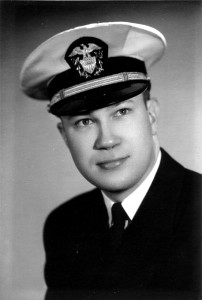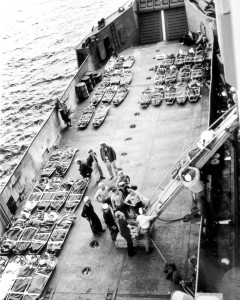A photo of survivors of Operation Tiger is part of the collection donated to UT Knoxville’s Center for the Study of War and Society
Investigation of a World War II Practice Invasion Lives on at UT
By Diane Ballard
Bodies floated in the frigid sea. What was to have been a practice for the Normandy invasion had gone fatally wrong.
Eugene Eckstam lived with the memories for decades before he resolved to find out everything he could about the shadowy incident. He learned a lot, and he gave all his research to UT Knoxville.
Eckstam, who died in 2010, survived Operation Tiger, the ill-fated rehearsal for World War II’s D-Day. German torpedo boats disrupted the exercise on April 28, 1944, off the southern coast of England, sinking two U.S. landing craft and damaging a third, resulting in almost 750 deaths. News of the tragedy was suppressed to ensure the secrecy of the Normandy mission.
Eckstam was born in Memphis and reared in Madison, Wis. He spent his career as a physician in Monroe, Wis., and, after retiring, devoted himself to uncovering the facts about Operation Tiger. His research resides in the UT Knoxville Center for the Study of War and Society in Hoskins Library.
The operation, also known as Exercise Tiger, was led by Gen. Dwight Eisenhower. The location, near the hamlet of Slapton Sands in south Devon, was chosen because the geography was similar to Utah Beach on the coast of France. The landing craft were caught unaware of the impending attack because they were tuned to the wrong radio frequency. When the torpedoes struck Eckstam’s ship, they took out the power source, leaving the ship in darkness and unable to run pumps to fight the flames.
In an interview decades later, Eckstam recalled the “huge … roaring fire.” “Fuel-loaded trucks were burning, and small arms ammunition was exploding. Worst of all were the agonizing screams from the Army men trapped in there. I can still hear them,” he said. The only way to escape was into the sea, where many lost consciousness and drowned. A small boat rescued Eckstam after about an hour.

“The survivors were taken to various army hospital units across southern England for examination and then to army and navy bases for reassignment, if able,” the Navy veteran wrote. “Most of us were told not to talk about the disaster on penalty of a court martial.” Reports released years later said physicians who treated survivors weren’t allowed to speak to them because of the deep secrecy surrounding the D-Day plans.
Eckstam found that a mention of the Operation Tiger disaster appeared in U.S. newspapers in July 1944. Some information was declassified in the mid-1950s, he said, and all information was made public in the early 1970s. “But none of these releases were publicized,” Eckstam wrote.
Today a plaque with the names of those who died and a tank, which sank during the operation and was recovered by a local resident, mark the location on the beach near where the disaster occurred.
Cynthia Tinker, project coordinator in the Center for the Study of War and Society, says a mutual friend put Eckstam in touch with Charles Johnson, a professor of American military history and founder of the Center for the Study of War and Society. “Dr. Johnson [now deceased] and all of us that followed just stayed in touch with Dr. Eckstam all those years, and he sent things in over that time,” Tinker says. “But finally, in the summer of 2004, he brought his entire research collection down from Minnesota.”
The collection is voluminous. Eckstam collected lists, letters, medical records, burial information, government reports, and articles and broadcasts that eventually surfaced about Operation Tiger. His research took him to the naval archives and to England. He contacted both Army and Navy survivors, arranged reunions and even communicated with the commander of the German boat that torpedoed his ship.
Despite the tragic Operation Tiger experience, Eckstam participated in the Normandy landing and served for two more years. He matter-of-factly summed up his war experience in a letter to Johnson: “I was a medical officer, fresh out of internship, from Jan 44 thru May 46. Got sunk by E-Boats April 28, 44, invaded Normandy anyway June; time in States (CA) then invaded Mindanao, staged in Panay and sat out the end in Manila.”
Eckstam’s work lives on not only in the collection he donated to UT but also via the Exercise Tiger Trust in the UK, which uses much of his research on its website, exercisetiger.org.uk, to commemorate the Americans who died in the operation.




